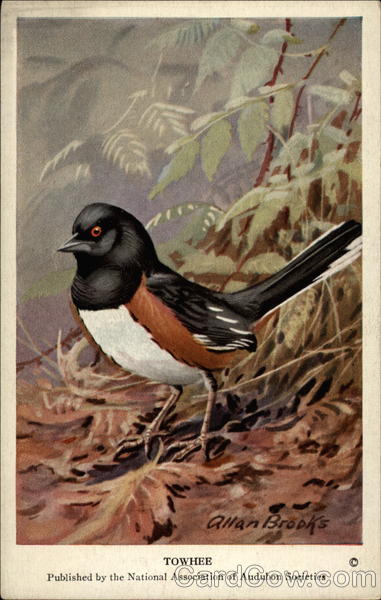Front:
anan Brooks
TOWHEE
Published by the National Association of Audubon Societies
Back:
No. 35 Towhee
Length 814 inches
This active, energetic bird, sometimes called
“Chewink” and “Ground Robin,” is a general
favorite with all those who love the woodland
ways. Although a cousin to all the Sparrows
and Finches, his tri-colored coat of black, white
and rufous set him apart as one of the conspicu-
ous members of the family. He is seldom found
far from thick undergrowth and dusky, woodland
copses which are his favorite haunts. Here he is
equally at home in the cheerless days of winter,
when many a leaf-strewn hillside rustles in re-
sponse to his vigorous scratchings, or again in
summer when his far-carrying musical notes ring
through the verdant glooms of mandrake and
sassafrass.
The song of the Towhee, while possessing few
if any of the characteristics which have made
our best-known vocalists famous, nevertheless has
about it an indescribable, ringing clearness which
seems to be the very expression of joyous wood-
land mirth.
The nest is on or near the ground, of strips of
bark and dry leaves, lined with fine grasses. From
four to five eggs, speckled or blotched with
rufous, are laid.
Classification: Order Passeres. Family Fringillide.
Scientific name: Pipilo erythropthalmus erythrop-
thalmus.
Range: Eastern North America. Breeds from south-
ern Canada, south to northern Georgia and central
Kansas. Winters from Ohio and Potomac Valleys south
to Gulf Coast.
No. 35 from set of 50 Spring Birds of Eastern North America.
Published by the National Association of Audubon Societies,
1974 Broadway, New York City. Price per set, in a box, $1.00
post-paid.



